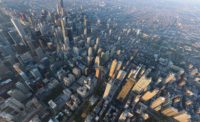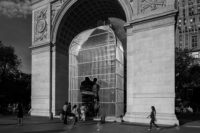Born in Israel and educated at the Architectural Association (AA), Eyal Weizman could be considered more a detective than an architect. In 2011, Weizman established Forensic Architecture, an agency based at the Centre for Research Architecture at Goldsmiths, University of London. He directs the center. The group, whose funders include the European Research Council, combs through data such as smartphone footage, satellite imagery, maps, and phone logs to create three-dimensional spatial maps of conflict sites, using architectural rendering software and other analytic tools. Significant projects have included full-scale replicas of key elements of Auschwitz gas chambers and incinerators for an exhibit at the 2016 Venice Architecture Biennale, and an investigation into the U.S. bombing of a Syrian mosque last year. The firm, which was just shortlisted for the Turner Prize, is currently scrutinizing the deadly blaze at London’s Grenfell Tower in June 2017, mining publicly available footage to create a 3-D model that will serve as an open resource for people to better understand the events that led to the fire. Weizman spoke to RECORD from the group’s office at Goldsmiths.
When did you realize that you didn’t want to build but instead to pursue the investigative architectural research that you do?
As a student at the AA, I was very research-oriented and interested in politics and theory. About halfway through my education, I began mapping Israeli settlements in the West Bank and the human rights violations that were occurring there. My study was featured in several human rights reports and was also presented as evidence to the International Court of Justice. So that experience really showed me the political power of architectural analysis and how it could become a counter-cartographic tool in confronting injustice.
You have a degree in architecture, and your office is called Forensic Architecture, but your work is the result of a very multidisciplinary effort. Do you consider what you do architecture?
Yes. But for us, architecture is a place we depart from; it’s more like an airport than a prison. To provide architectural evidence of, say, a destroyed building in Syria, we are often unable to actually go on-site. We need to locate, verify, analyze, and stitch together user-generated content in order to make a narrative. Spatial analysis involves understanding components such as media or the memories of survivors, so we have software developers and forensic psychologists; we have to understand the theoretical implications of certain types of ammunition used, for example, so we have lawyers in our group. Following the evidence means setting up a team composed of multiple skills and talents.
The Grenfell Tower project is different from some of your other investigations in that you aren’t trying to find a culprit per se. We know that the cladding and insulation are to blame for the fire’s rapid spreading. So what are you trying to achieve?
I think the Grenfell Tower tragedy is a defining tragedy for Londoners, especially those in my generation, because we have seen the ways in which privatization and other features of the neoliberal economy have started to affect the very fabric of our cities and buildings. The story of the night of the fire is connected to a set of decisions that reveal a history of the deregulation processes that have taken place. The Grenfell Tower is not simply the story of the cladding; it’s a combination of microstories—stories of families, of policy, of material elements. By creating a spatial database from video footage, interviews, telephone calls, Facebook posts, text messages, radio communication, etcetera, we can have a precise picture of this tragic event and honor what took place.
We live in tumultuous times; how do you see Forensic Architecture’s role evolving in the near future, with such global unrest?
I think that work such as ours has a very important political meaning now, considering the populist-right movement that is rising in Hungary, Poland, Turkey, Israel to a certain extent, and, of course, with Brexit and the Trump administration. All of these things have something in common—not a dispute of facts but rather an attack on the very possibility of establishing fact-based politics. The idea of calling everything fake news is slowing down the potential for evidence-based work. We think that there’s great importance in finding new ways of producing solid evidence on which to base our discussions and our political decisions. We plan to continue to use architecture as an off-place to understand, analyze, and intervene in political situations worldwide.






Post a comment to this article
Report Abusive Comment